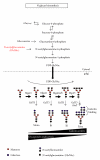Mgat5 deficiency in T cells and experimental autoimmune encephalomyelitis
- PMID: 22389815
- PMCID: PMC3263545
- DOI: 10.5402/2011/374314
Mgat5 deficiency in T cells and experimental autoimmune encephalomyelitis
Abstract
Multiple sclerosis (MS) is an inflammatory demyelinating and neurodegenerative disease initiated by autoreactive T cells. Mgat5, a gene in the Asn (N-) linked protein glycosylation pathway, associates with MS severity and negatively regulates experimental autoimmune encephalomyelitis (EAE) and spontaneous inflammatory demyelination in mice. N-glycan branching by Mgat5 regulates interaction of surface glycoproteins with galectins, forming a molecular lattice that differentially controls the concentration of surface glycoproteins. T-cell receptor signaling, T-cell proliferation, T(H)1 differentiation, and CTLA-4 endocytosis are inhibited by Mgat5 branching. Non-T cells also contribute to MS pathogenesis and express abundant Mgat5 branched N-glycans. Here we explore whether Mgat5 deficiency in myelin-reactive T cells is sufficient to promote demyelinating disease. Adoptive transfer of myelin-reactive Mgat5(-/-) T cells into Mgat5(+/+) versus Mgat5(-/-) recipients revealed more severe EAE in the latter, suggesting that Mgat5 branching deficiency in recipient naive T cells and/or non-T cells contribute to disease pathogenesis.
Figures



Similar articles
-
N-glycan processing deficiency promotes spontaneous inflammatory demyelination and neurodegeneration.J Biol Chem. 2007 Nov 16;282(46):33725-33734. doi: 10.1074/jbc.M704839200. Epub 2007 Sep 13. J Biol Chem. 2007. PMID: 17855338
-
Negative regulation of T-cell activation and autoimmunity by Mgat5 N-glycosylation.Nature. 2001 Feb 8;409(6821):733-9. doi: 10.1038/35055582. Nature. 2001. PMID: 11217864
-
N-acetylglucosaminyltransferase V (Mgat5)-mediated N-glycosylation negatively regulates Th1 cytokine production by T cells.J Immunol. 2004 Dec 15;173(12):7200-8. doi: 10.4049/jimmunol.173.12.7200. J Immunol. 2004. PMID: 15585841
-
The role of costimulation in autoimmune demyelination.J Neuroimmunol. 2000 Jul 24;107(2):205-15. doi: 10.1016/s0165-5728(00)00230-7. J Neuroimmunol. 2000. PMID: 10854658 Review.
-
Evidence that Fas and FasL contribute to the pathogenesis of experimental autoimmune encephalomyelitis.Arch Immunol Ther Exp (Warsz). 2000;48(5):381-8. Arch Immunol Ther Exp (Warsz). 2000. PMID: 11140465 Review.
Cited by
-
N-linked glycans: an underappreciated key determinant of T cell development, activation, and function.Immunometabolism (Cobham). 2023 Nov 21;5(4):e00035. doi: 10.1097/IN9.0000000000000035. eCollection 2023 Oct. Immunometabolism (Cobham). 2023. PMID: 38027254 Free PMC article. Review.
-
Self-antigen presentation by dendritic cells in autoimmunity.Front Immunol. 2014 Feb 13;5:55. doi: 10.3389/fimmu.2014.00055. eCollection 2014. Front Immunol. 2014. PMID: 24592266 Free PMC article. Review.
-
Deep learning explains the biology of branched glycans from single-cell sequencing data.iScience. 2022 Sep 19;25(10):105163. doi: 10.1016/j.isci.2022.105163. eCollection 2022 Oct 21. iScience. 2022. PMID: 36217547 Free PMC article.
-
N-acetylglucosamine inhibits inflammation and neurodegeneration markers in multiple sclerosis: a mechanistic trial.J Neuroinflammation. 2023 Sep 13;20(1):209. doi: 10.1186/s12974-023-02893-9. J Neuroinflammation. 2023. PMID: 37705084 Free PMC article.
-
Genetic Variants of the MGAT5 Gene Are Functionally Implicated in the Modulation of T Cells Glycosylation and Plasma IgG Glycome Composition in Ulcerative Colitis.Clin Transl Gastroenterol. 2020 Apr;11(4):e00166. doi: 10.14309/ctg.0000000000000166. Clin Transl Gastroenterol. 2020. PMID: 32352685 Free PMC article.
References
-
- Ebers GC, Sadovnick AD, Risch NJ, et al. A genetic basis for familial aggregation in multiple sclerosis. Nature. 1995;377(6545):150–151. - PubMed
-
- Ebers GC, Bulman DE, Sadovnick AD. A population-based study of multiple sclerosis in twins. New England Journal of Medicine. 1986;315(26):1638–1642. - PubMed
-
- Munger KL, Zhang SM, O’Reilly E, et al. Vitamin D intake and incidence of multiple sclerosis. Neurology. 2004;62(1):60–65. - PubMed
-
- Dyment DA, Sadovnick AD, Willer CJ, et al. An extended genome scan in 442 Canadian multiple sclerosis-affected sibships a report from the Canadian Collaborative Study Group. Human Molecular Genetics. 2004;13(10):1005–1015. - PubMed

